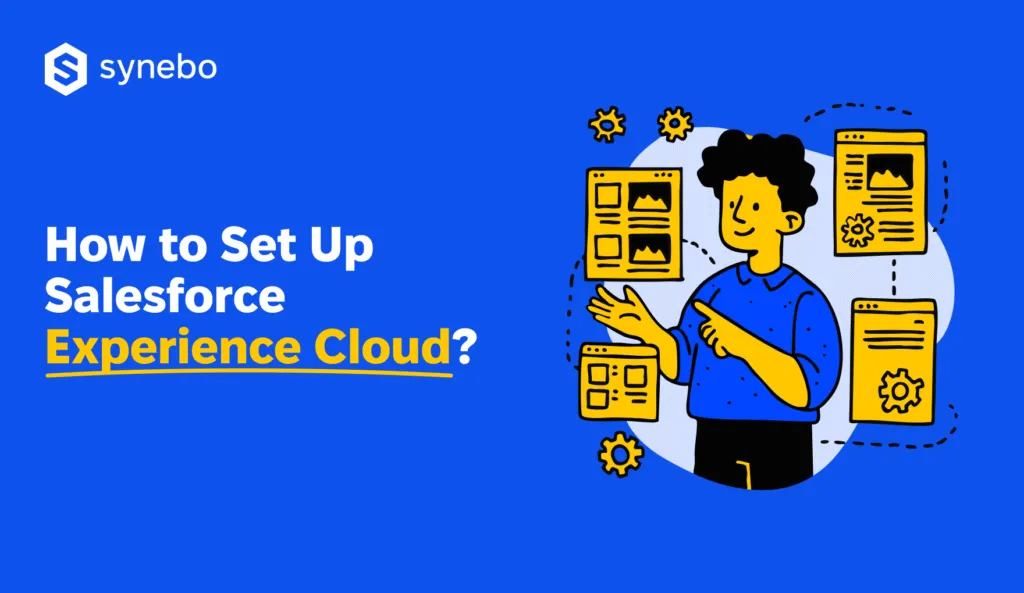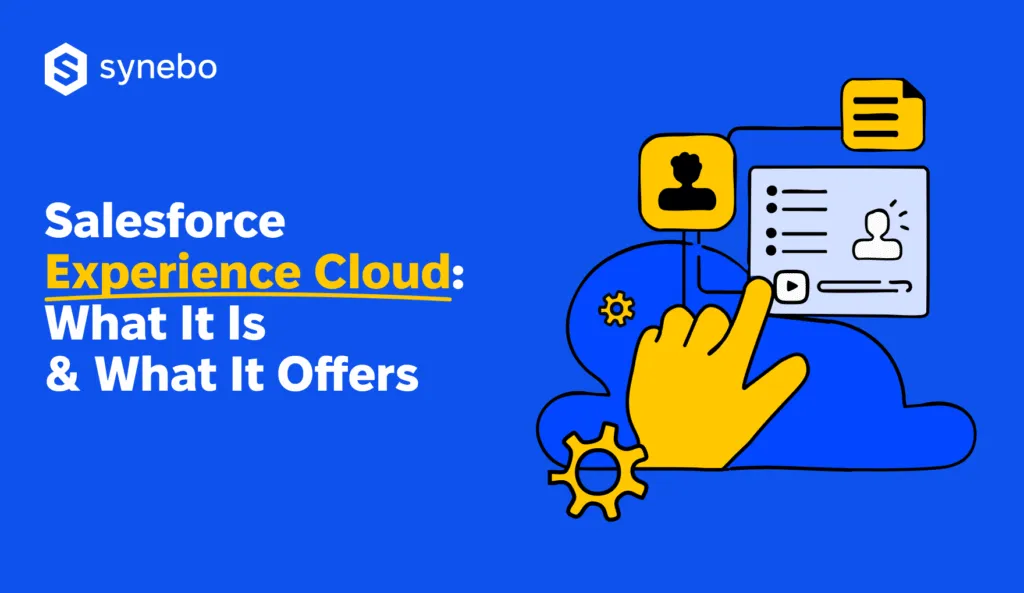Salesforce Experience Cloud vs Custom Portal Development: Which Wins?
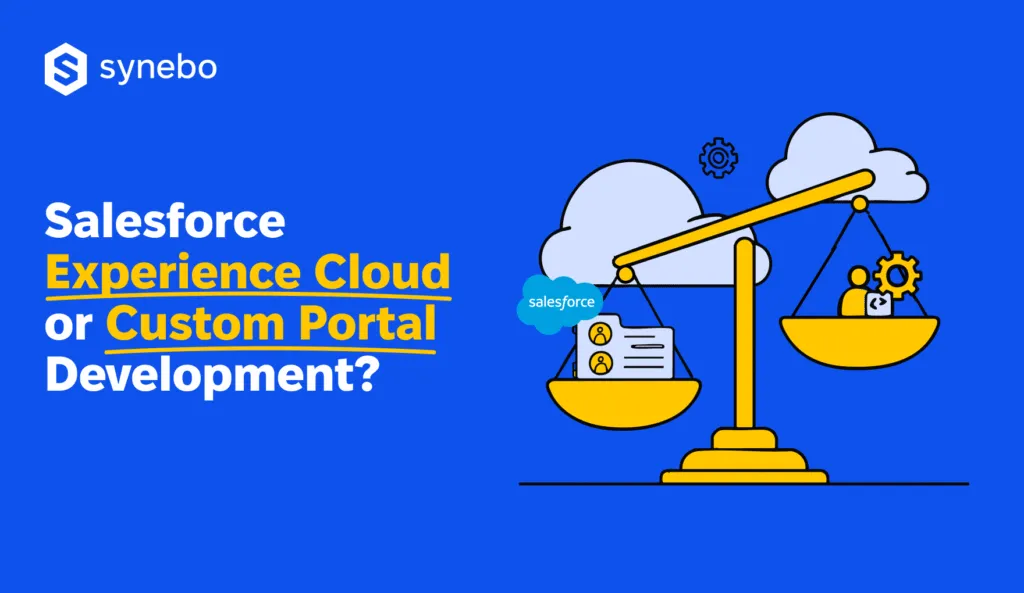
When you need a portal that connects users with your systems, you usually have 2 paths: deploy Salesforce Experience Cloud or build a custom portal. Each route carries its own trade-offs – and we’ll unpack all those in more detail as we go here. Yet, what instantly stands out is the gap in speed, integration, security, and flexibility.
Here’s the first clue: Experience Cloud isn’t just another fast portal builder. It does it with a really fast payoff, too.
The study says that companies that started using Salesforce Experience Cloud saw over triple the value back on every dollar they spent. Plus, they gained USD6.6 mln in benefits, and reached full payback in under six months. In other words, this platform starts making money before the “break” of the fiscal year.
What’s more, that return is built into the SF ecosystem. Your portal connects directly to the CRM workflows, automates interactions with customers/partners, and scales with you.
When developing a custom portal, you – by contrast – enjoy full creative freedom and integration with any stack. To cut straight to the point – уour custom space works perfectly when every detail must reflect your unique workflow or brand identity.
So, in this article, we’ll explore what Salesforce Experience Cloud is used for and when bespoke portals are more beneficial. We’ll look closely at the advantages and capabilities of both. The info will help you decide if to pick this Cloud or custom portal solutions.
Experience Сloud or Playground? Choosing Your Portal Path
Before you commit to your strategy, we recommend that you step back and see your playing field. Salesforce Experience Cloud and custom portal development approach the same goal – connection with your customers (or other key audiences) – from two very different directions.
The first relies on a proven ecosystem. The latter builds freedom from the ground of imagination and code.
Let’s evaluate the edges you get from each approach.
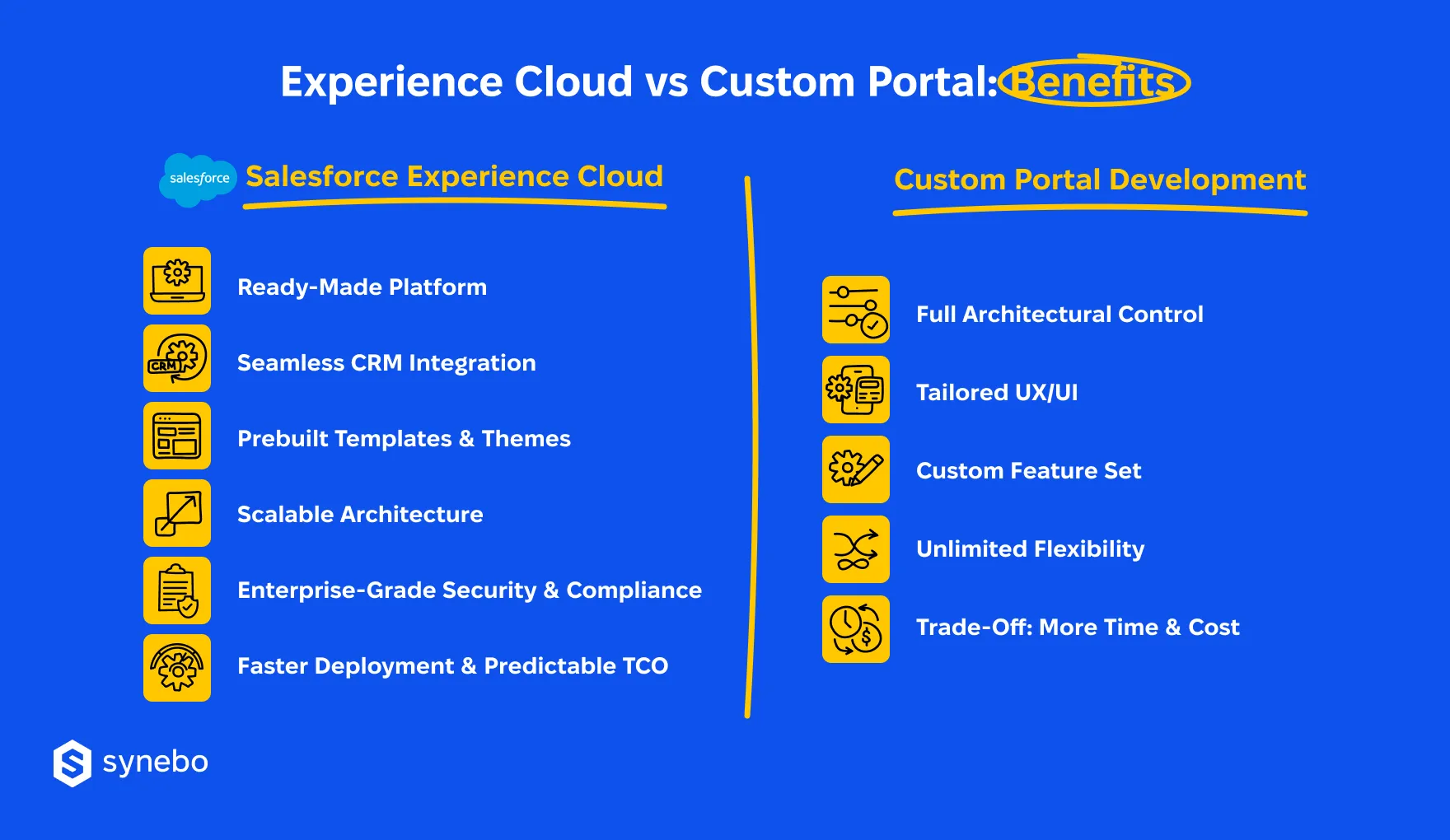
Salesforce Experience Cloud Benefits
It acts as a ready-made foundation for digital engagement of whatever your target group(-s). It empowers your crew to move swiftly, and you don’t have to reinvent architecture or security models.
Specifically, key benefits of Salesforce Experience Сloud are:
- Ready-made platform – built on SF infrastructure and allows instant access to tested functionality and governance.
- Deep integration with the SF environment – workflows, automation, and – it’s essential – records stay under one roof and are synced.
- Prebuilt templates and themes – those significantly accelerate your portal creation and can also maintain your corporate branding.
- Scalability – supports growth across/for clients, agents, allies, partners, or employees – without architectural redesign.
- Security and compliance – benefits from SF’s continuous audits, encryption standards, and global certifications (for instance, readiness for SОС 2, GDPR and more).
If your company already lives in the Salesforce universe, the Salesforce Experience Cloud benefits surely gives you faster go-live (we’d say instant as compared to bespoke builds) and predictable maintenance costs.
Read Also: What is Salesforce Experience Cloud, and What You Get From It?
Your Gains with CRM Custom Portal
A portal you craft from scratch, on the other hand, represents your full creative command. It lets you design experiences that reflect your brand character and operational logic. And you have almost no external limits.
When developing a custom portal, you enjoy:
- As much flexibility as you want. You get complete authority over the site architecture, tech stack, and deployment model.
- UX/UI built your way and around your users. Its interfaces mirror your unconventional workflows or specific journeys of your customers (or other target groups).
- Absolute control over features. You have the ability to shape every module to your business priorities.
However, what’s worth mentioning here is that together with total freedom, a custom portal brings higher development time, cost, and maintenance. This is a trade-off for owning every decision from infrastructure to future updates.
As you see, both directions hold merit. Your choice, in fact, will reflect how much speed, freedom, and control you want.
As а Salesforce Experience Cloud partner, Synebo designs spaces for employees, agents, clients – quick to deploy, flawlessly integrated, and ready to scale effortlessly. If you look to harness or get more from Salesforce Experience Cloud, contact us.
Detailed Comparison of the Options
As one of our clients once said, “Every initiative faces a quiet duel between ambition and pragmatism”. He is right: with the options we are discussing, speed competes with control. Cost wrestles with customization. Salesforce Experience Cloud and custom portal development sit at opposite ends of this spectrum. Аnd each performs best in its own context.
Let’s compare the key factors that can steer your choice.
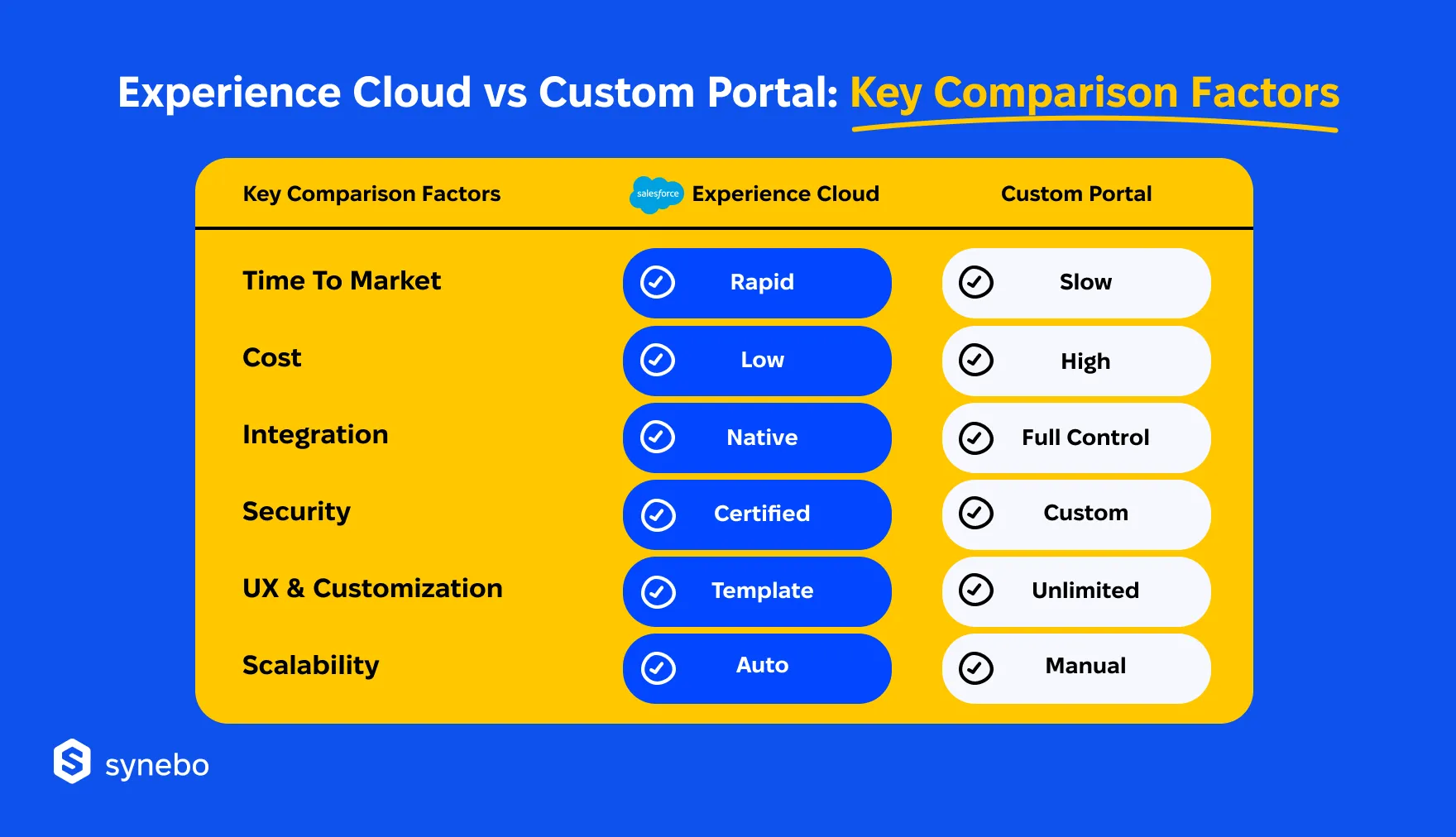
How Quickly It Reaches Your Audience
- SF Experience Cloud accelerates delivery thanks to ready infrastructure and preconfigured templates. You can launch your portal(s) in weeks instead of quarters.
- Custom portal development requires design from scratch, coding, and a testing cycle. It’s objectively much longer to build (yet, when done right, can be more adaptable later).
How Much It Costs for You
- Salesforce Experience Cloud minimizes upfront investment – through subscription pricing. It also reduces technical debt. Yet, customization limits sometimes – not often though – push some businesses toward more costly workarounds.
- Custom portal solutions demand heavier initial budgets on design, engineering, QA. However, they deliver full ownership with no license dependency and scaling capabilities you can predict.
How Easily It Connects Your Data and Accesses It
- The Salesforce Experience Cloud capabilities allow data to communicate directly with Salesforce CRM, marketing, and service tools, and ensure a unified source of records. (External integrations, however, may need middleware or APIs)
- CRM custom portal – when done expertly – can provide unrestricted access to various CRMs, ERPs, and/or other bespoke systems. It grants your devs full command over data flow and architecture.
How Secure and Compliant It Stays
- Salesforce Experience Cloud inherits top-notch security with layered encryption, managed access rights, and certified adherence to SОС 2, ІSО 27001, and GDРR. For regulated sectors like healthcare or finance, that matters a lot.
- Сustom portal’s security, on the other hand, depends entirely on your internal standards, audits, and diligence of infrastructure.
How Easy and Customizable It Is
- The Salesforce Experience Cloud features include a bunch of flexible templates plus branding control (though deep design alterations can be limited by the platform constraints).
- Custom portal solutions remove all restrictions. Whatever UI, animations, and flows become an open canvas for your UX innovation.
How Painlessly It Scales as You Expand
- Salesforce Experience Cloud handles scaling automatically as traffic grows. This is a native aspect of the SF ecosystem itself.
- Custom solutions require that you plan your infrastructure and monitor its condition yourself. Yet, it can provide broader freedom to evolve technology stacks or adopt new frameworks later – in fact, everything is up to you.
As a closing note from us, Experience Cloud delivers velocity, stability, and governance. Portals you develop yourself offer autonomy, originality, and potentially deeper functionality.
How you decide springs from where your company draws the line between control and convenience.
Use Cases: Where Each Approach Proves Its ROI
As the Salesforce-certified Experience Cloud consultants, we firmly believe that no technology wins by theory alone. Our vast experience proves it all the time: any tool or platform wins when it solves real business tension.
Salesforce Experience Cloud and custom-built portals cater to different priorities, budgets, and cultures of decision-making.
Let’s explore where each approach delivers its strongest return.
When Salesforce Experience Cloud Implementation Makes Sense
The Cloud fits those organizations that seek acceleration and don’t want (and can’t afford) to sacrifice governance/compliance. It makes sense when your goal is to connect faster, not to reinvent how connection happens.
So, frequent Salesforce Experience Сloud use cases include:
- Customer or partner sites tied directly to Salesforce CRM. For example, a manufacturing firm that wants distributors to track orders or warranty claims without separate data pipelines.
- Employee enablement platforms. If you need to centralize onboarding, training, or performance data in Salesforce, you 100% benefit from the Salesforce Experience Cloud unified architecture.
- Support communities or knowledge hubs. They become possible (and fast) thanks to prebuilt templates for case management, chat, and self-service, which drastically reduce launch time.
- Regulated sectors. Banking, insurance, healthcare companies, and suchlike often prefer Experience Cloud for its built-in compliance and audit frameworks.
This path is perfect if you prioritize speed, governance, and ongoing reliability, as Salesforce Experience Cloud implementation ensures efficiency and consistency. It limits reinvention but rewards consistency.
When Custom Spaces Are Worth Your Investment
We’d say a custom portal serves those companies that treat digital experience as a signature, not a standard. If you – your brand – refuse to operate inside fixed templates, bespoke solutions are surely your choice.
Such solutions are best suited for:
- Complex multi-system environments. If your business(-es) connects multiple CRMs, ERPs, and 3d-party apps, plus the flexibility of data orchestration matters for you more than speed, a custom-made site puts your multi-system environment fully in your hands.
- Product or service platforms with distinctive UX logic. Some SaaS providers, logistics firms, and more need specialized workflows or аtypical navigation structures.
- Brands that emphasize a unique digital identity. If your design becomes a statement and you use specific animations, microinteractions, or storytelling-driven layouts, in this case custom portal development delivers that creative control your brand requires.
- Highly specialized business needs. Some companies operate experiences so unique that even scalable platforms like SF need extensive customization (examples: fintech risk calculators, multi-step logistics routing simulations, SaaS platforms with branching onboarding flows, etc). In these cases, a fully bespoke portal gives complete control.
So, as you see, Salesforce Experience Cloud quickens rollout and simplifies growth inside a trusted ecosystem. Custom portal solutions expand possibilities beyond it. Both routes deliver true value. Your pick is determined by your strategy.
Specifically, if you need acceleration or distinction.
Need an SF portal that scales securely, lets you move fast, and puts your customer/agent data to smart use for further upselling? Synebo’s Salesforce Experience Cloud consulting services can help you build a space that does it all. Contact us.
Questions That Shape Your Right Portal Decision
So, we’ve gone through the benefits, differences, and use cases of each approach. By now, you may have a general understanding of which direction makes the most sense for you.
If you’re still unsure, this checklist can help you take your final decision:
☐ Do we already use SF as our primary customer data platform?
☐ Is speed critical to deployment for our project timeline?
☐ Are we ready to trade flexibility for fast(-er) delivery and lower risk?
☐ How tailored should our UX really be? Is it really necessary?
☐ Do we need integrations beyond SF? Deep links with ERPs, data platforms, external tools?
☐ How critical is our data protection? Any (what?) compliance rules we have to follow?
☐ Who is/will be responsible for kеерing our portal working well (and infrastructure)?
☐ What’s our total cost tolerance – both initial and ongoing?
☐ How fast could our users multiply? Is our architecture ready for this surge?
☐ Is a standout design and UX essential to how our brand is perceived?
☐ Do we have in-house expertise to manage our solution, or will we depend on partners?
Your answers reveal not only which approach – Salesforce Experience Сloud or a custom platform – fits your business today. They also help you see which decision sustains your tomorrow’s growth.
What Your ‘Yes’ Tells You
Your answers may surely vary. Yet, the following answers (in fact – your needs) are key indicators.
So, if you answered “yes” to the following:
✅ We already use Salesforce as our main CRM
✅ We need to deploy quickly
✅ Compliance and governance are critical for us
✅ Our customization needs/expectations are moderate
→ Salesforce Experience Cloud is your fastest, most stable route forward.
If your “yes” іnclude these options (and their variations):
✅ We need dеер customization and UX that no platform offers
✅ Multiple integrations beyond SF are crucial for us
✅ We want full control over infrastructure and data
→ A custom portal will reward your ambition with creative and technical freedom.
What if your answers split more or less evenly? Our experience shows that hybrid strategies work too. Some enterprises deploy Salesforce Experience Cloud for partner or customer communities and build custom portals for their specialized products or specific operations.
Deciding Your Next Move
So, after weighing all the benefits and specifics, your decision – hopefully – rests on priorities rather than hype. Salesforce Experience Cloud delivers rapid deployment, predictable maintenance, and it lives inside SF – ideal if you value reliability, compliance, and are accelerating your presence online.
Synebo specializes in Salesforce consulting, implementation, and Experience Cloud solutions – in particular. We help companies craft digital spaces that efficiently connect their clients, ecosystem members, business agents, colleagues, and scale confidently.
Reach out to us to see how our Salesforce Experience Cloud services can accelerate your initiatives and turn them into visible achievements for your business.
The Cloud offers a ready-made, secure platform, which is tightly integrated with Salesforce CRM. It enables quick deployment and then ongoing reliability. Custom-made sites give you full control over design, features, and integrations. Yet, to build them, you’ll likely spend more time, investment, and technical resources.
Choose Experience Cloud if your company already has an org in SF, wants fast(-er) deployment, and prioritizes compliance. This Cloud excels for teammate/partner/client /agent portals, especially if core processes need quick activation. If you demand quick results with predictable operations (rather than a fully bespoke design), Experience Cloud provides a good balance between speed and functionality.
It suits client networks, collaborator spaces, knowledge&info centers, and staff interaction portals. It supports purchase monitoring, issue handling, skill development, and team ramp-up. It also leverages data in your SF. Plus, all industries – and especially regulated ones – benefit from its built-in compliance.
Pros: prompt deployment, deep SF integration, reliability, powerful security, scalability, and compliance certifications. Cons: customization is limited by platform constraints, and advanced 3d-party integrations may require additional middleware. Also, unique UX designs sometimes cannot be fully implemented.
The first generally requires lower investment upfront. Its subscription costs are predictable. It all reduces technical debt. Bespoke platforms demand higher initial budgets for design, development, and testing. Рlus, factor in ongoing infrastructure and maintenance expenses. In the long term, what shapes your further investment is scaling, integrations, and your internal expertise


